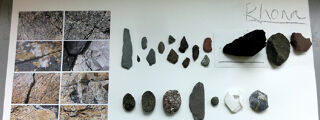International jewellery makers responding to themes of relocation and identity around the North Berwick coast and the poetic lyrics of Bob Dylan's famous 'Like a Rolling Stone'.
Rhona McCallum, samples worksheet.
Researchers and exhibitors
- Stephen Bottomley (Principal Investigator)
- Susan Cross
- Rebecca Crowther (PhD researcher)
Exhibitors
- Stephen Bottomley (UK)
- Susan Cross (UK)
- Maria Rosa Franzin (IT)
- Jessamy Kelly (UK)
- Gigi Mariani (IT)
- Rhona McCallum (UK)
- Jo Pudelko (UK/CAN)
- Jessica Turrell (UK)
- Gabi Veit (IT)
- Cristina Zani (UK/IT)
Research background
‘Like a Rolling Stone’ is an exhibition that followed a 2016 workshop which invited ten international contemporary jewellery makers to visit the geological sea/landscape of North Berwick, Scotland. In-situ they were asked to respond to themes of relocation, transplantation, camouflage, identity and materiality in the works they made. The Italian Cultural Institute Edinburgh funded three Italian Goldsmiths, as part of the 2016 Year of Italian Innovation, Architecture & Design,who joined seven UK Jewellery artists (including Bottomley and Cross).
North Berwick has a long association with scientific research. Frequented in the 18th century by ‘father of modern geology’ James Hutton, it was instrumental in proving his revolutionary theories of the earth’s age through the movement of matter. The Berwick trip included geological field notes for each artist to engage with the topophilia and nascent ‘sense of place’, explored through interviews with PhD researcher Rebecca Crowther and documented by photographer Shannon Tofts. Geological research heritage was juxtaposed to contemporary human-centred themes of enquiry reflected in the poetic lyrics of Bob Dylan’s song ‘Like a Rolling Stone’.
Research aims
A 2016 studio-based workshop invited ten international contemporary jewellery makers to visit the geological sea/landscape of North Berwick, Scotland and respond to themes of relocation, transplantation, camouflage, identity and materiality in the works they made, working individually, but sharing experiences and ideas as group of makers.
Research methods
This study combines ethnographic and anthropological narratives to explore open and multi-media creative studio practice through a maker’s lens. The participants shared the same geographical space, temporal conditions and stimuli and applied their own individual practice-led research methodologies, in a “multimethod' or triangulated approach, acknowledging the complex nature of practice-based inquiry in a transient cultural and contextual framework” (Malins & Gray).
The Berwick trip included geological field notes for each artist to engage with the topophilia and nascent ‘sense of place’, explored through interviews with PhD researcher Rebecca Crowther and documented by photographer Shannon Tofts illustrated in the A 52-page catalogue published by Birmingham City University, edited by Bottomley, with essays by Crowther and Bernabei.
Research outcomes
All the artists, irrespective of the use of material, made their own original contributions to the field of jewellery as an art form as well as a ‘’communication tool to examine conditions of conscience’’ (Bernabei ‘The conscience mirror’, Like a Rolling Stone catalogue, p.48)
The exhibition opened at Munich’s State crystal,mineral and geological museum, the Museum Reich der Kristalle, Mineralogische Staatssammlung München, during the 2017 International Jewellery festival. The catalogue was launched with a presentation at the International Handwerk Messe (10.03.18) and on the Chrome and Yellow Book stand, with profits going to the charity ‘Help Refugees’.
